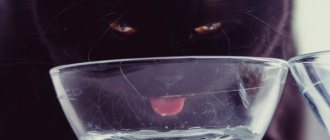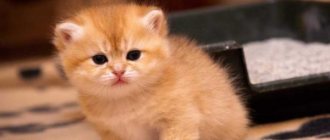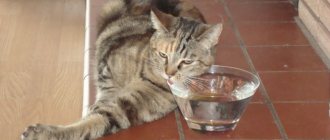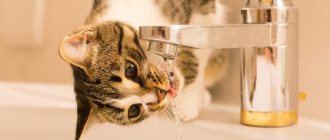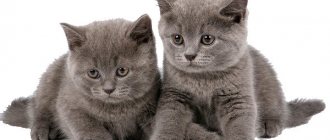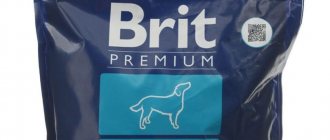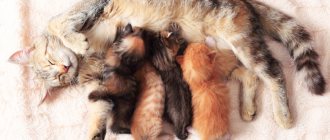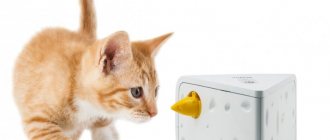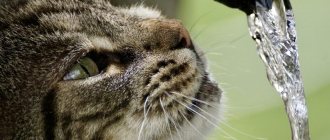Every owner of a mustachioed pet should know how much water a cat should drink per day. Failure to comply with the norm recommended by veterinarians is dangerous and can lead to unpleasant consequences. To avoid them, it is important to calculate your actual fluid intake and bring it to the required level using a few tricks.
What affects water consumption
The daily water requirement for a cat is individual. With age, due to a slowdown in metabolic processes, it gradually decreases. A larger deviation is typical for pregnant pets - when carrying kittens, part of what they drink is transformed into the amniotic sac and milk.
In addition to age and physiological condition, it is necessary to take into account several more important factors: the type of feeding, the mobility and size of the animal, as well as the climatic conditions in the place of residence.
Nutrition
When feeding natural food, up to 75% of the liquid comes from food. The cat gets moisture from fermented milk products, vegetables, herbs, cereals, meat and fish.
With dry granules, the animal receives only 10% liquid. To maintain water balance and comfortable digestion of food, you need to drink a portion that is 2 times the volume of what you eat. Otherwise, an increased concentration of proteins and minerals may result in the formation of stones (kidney or bladder stones).
Body type and activity
The greater the mass of a mustachioed pet, the less its norm per kilogram. Calculation formulas for a miniature cat weighing only 2 kg and a large cat whose weight exceeds 10 kg will be different. In absolute terms, an animal with a powerful physique will have to drink more, but in relative terms, the need will be higher for those who are smaller.
In addition to size, daily activity is also important. Cats that roam freely on the street expend more energy and moisture reserves than those that spend almost the entire day on the couch.
Ambient temperature
Increased human sweating plays an important role in thermoregulation. Thanks to sweat, people can tolerate heat much more easily than pets. In the cat family, sweat glands are located on the pads of their paws - this is why wet marks from cat paws appear on the floor in the summer.
To lower their body temperature, mustachioed pets lick themselves more often, covering their coat with copious amounts of saliva. When it evaporates, a short-term cooling effect occurs. Accordingly, the cat drinks more than normal to produce a copious amount of saliva.
The higher the ambient temperature and the drier the air, the faster moisture is lost. In damp and cool weather the situation is reversed.
Physiological causes of increased thirst
Owners often wonder why their cat drinks a lot of water, and forget about the physiological and completely natural causes of increased thirst:
- Intense physical activity.
- Pregnancy and breastfeeding. While carrying kittens, as well as during the period of feeding, cats usually become thirsty. During these periods, the body requires a lot of fluid to form amniotic fluid and produce milk.
- Elderly age.
- Increase in body weight. Cats that are overweight require much more fluid for the normal functioning of the body than their slender relatives.
- Features of the diet. Cats that eat exclusively wet food drink very little water and pee less often because their body's fluid reserves are replenished with food. Accordingly, pets who eat only dry food often experience increased thirst. Also, a cat begins to drink a lot of water when it is suddenly switched from wet food or natural food to ready-made dry food. It contains a small percentage of liquid, and the animal thus replenishes moisture loss.
- Increased air temperature outside and at home.
- Diarrhea. One-time diarrhea in cats does not require medical attention. It can cause increased thirst because diarrhea releases a significant amount of fluid from the body through feces. If a cat's diarrhea recurs more than once a day, the owners should take the animal to the veterinarian.
- Taking certain medications. When treating various diseases, side effects from taking certain medications often occur. For example, cats that take corticosteroids, as well as diuretics, painkillers and sedatives, drink more often.
Why is water so important to animals?
Despite the fact that up to 70% of a mammal's body consists of water, it constantly needs to be replenished from the outside. It is found in the blood, muscles, bones and is involved in the most important internal processes:
- delivers oxygen to cells;
- maintains a constant body temperature;
- lubricates joint tissues and mucous membranes;
- dissolves nutrients, facilitating the digestion and absorption of food;
- removes toxins from the body that accumulate in waste products;
- humidifies the air in the lungs.
Prolonged lack of moisture leads to a reduction in urination and increased urine concentration. This is fraught with the development of urolithiasis, cystitis and kidney pathologies. If you do not give your pet the recommended amount of fluid, he may get sick or die from dehydration.
Refusing water or not drinking enough
What to do if your cat doesn't like to drink? When it is confirmed that she drinks too little water during the day, you can try several ways that will encourage her to drink more fluid:
- Change water containers, for example, choose a wider cup or replace plastic with ceramic or glass.
- Replace the suggested water. For example, start purifying plain tap water using filters or replacing it with store-bought bottled water.
- Make an imitation of a flowing pond by installing a small fountain with circulating water. Many cats prefer to drink running water.
- Change the place where the cup of water is. A cat may not like to drink in one place, but will happily do so in another. To determine the most convenient place for her, you need to place several sippy cups around the house, and then check the amount of water drunk in each of them.
- Change the water in the bowl more often - several times a day, especially in the warm season. The cat will not want to drink water that is not fresh or not clean enough. She will not tolerate pieces of food in a bowl of water. Therefore, it is better to move the drinking bowl away from the cup of food so that its pieces do not fall into the water while eating.
- Replace food.
You can form the habit of drinking in a kitten if you offer him cool water in a wide, comfortable cup after active play.
The animal may drink less in damp, humid weather. During the period after surgery, the cat may also refuse water. In such cases, it is better for the owner to wet the mucous membranes with it to prevent them from drying out.
If a cat refuses to drink, despite any tricks, it is worth having its health examined by a specialist.
Significant dehydration and intoxication of the body threaten the cat already on the second day after completely refusing water.
Norms of fluid intake per day under different conditions
Felinologists have established that the daily water requirement for an adult cat is 20-40 ml per 1 kg of weight. The indicator is adjusted up or down depending on the previously listed factors. For kittens, the estimated amount of ml is increased 2-3 times.
E. G. Grünbaum, German author of the work “Nutrition and Diet of Dogs and Cats,” suggests using more accurate indicators:
- 31.5 ml per 1 kg – for adult animals;
- 77 ml per 1 kg – for pets under one year old.
This option is more convenient for calculations, but less accurate. Cats of the same weight, but with different types of feeding, will have to be given water in different proportions. Otherwise, an animal that eats only “drying” may suffer from stones in the bladder.
Water comes not only from the drinking bowl, but also from other sources:
- broths and gravy from pates;
- well-cooked porridge;
- fermented milk products and milk;
- vegetable and fruit juices;
- raw or boiled pieces of meat, fish and offal.
When wet canned food is included in dry feeding, the amount of moisture received increases to 80%, and when using granules alone, it remains at 10%. The body is also able to synthesize fluids on its own using the food it receives:
- 0.41 ml from 1 g proteins;
- 1.07 ml from 1 g fat;
- 0.55 ml from 1 g carbohydrates.
Thus, the amount of water per day for a cat eating natural food or wet canned food will be less than that of a “cracker” lover.
Despite this, it should not fall below the minimum value (20 ml per 1 kg of weight). This amount is necessary to maintain basic life processes.
When feeding “drying”, proceed from the amount eaten. If your pet eats 55 g, then he will need at least 110 ml.
Water quality and its benefits for the body
The health of cats depends, among other things, on what kind of water they drink and how much. In young animals, the water content in the body is approximately 70%. They have a faster metabolism. The cells and tissues of the body of an adult cat contain about 50% water.
Not a single vital process in the body is possible without the participation of water. It is necessary for breathing, blood circulation, digestion, and thermoregulation. Water is a solvent and helps nutrients enter cells. A lack of moisture leads to a slowdown in metabolism and provokes the development of urolithiasis. If there is a lack of fluid, the water-salt balance is disrupted and the blood becomes excessively thick.
The quality of water offered to a cat is of considerable importance. It should be given exclusively clean water. There are several options to choose from:
- Regular tap water. It is the most unsuitable due to the high content of chemical impurities and salts;
- Boiled. It brings less benefits than usual due to its poor mineral composition. In addition, during the boiling process, sediment falls out - various solid particles. Consumption of boiled water can lead to the appearance of stones in the urinary tract;
- You can leave tap water in a cool, dark place for several hours. Under these conditions, chlorine will evaporate, and other impurities will precipitate;
- Filtered water passed through any household filter is suitable for cats;
- The best option is to offer your cat store-bought drinking water bottled. It has the most balanced composition of mineral elements.
Giving an animal medicinal mineral water is dangerous to its health. It contains a high concentration of salts and carbon dioxide.
Why does a cat drink more or less?
Deviation from the norm is dangerous in both directions. If your pet drinks too little, he is at risk of dehydration, and if he drinks too much, he may develop kidney failure or diabetes.
Extreme thirst
While maintaining good health, severe thirst is explained by pregnancy, overheating, dry air and excess salts in the diet. The first reason goes away on its own, the second is eliminated with the help of a fan and frequent wetting of the animal with a spray bottle, the third is by purchasing a humidifier, the fourth is by revising the diet in favor of better quality feed.
If none of the above reasons apply, then it is better to have the animal checked by a veterinarian. In the presence of pathology, accompanying symptoms may appear:
- reduction or frequency of urination;
- darkening of urine and the appearance of a strong ammonia odor;
- temperature increase;
- refusal to eat and loss of activity;
- the appearance of blood in urine.
Based on the results of the studies, the pet may be diagnosed with kidney disease, liver disease, purulent inflammation of the uterus, diabetes mellitus or a viral infection. A lack of minerals can also cause severe thirst. In this case, the animal may begin to eat soil from pots with indoor plants.
Water refusal and dehydration
If a kitten drinks little water, it may die within the first day. Adult animals with dehydration die only on the 3rd day, but this is not a reason to avoid the veterinarian when the first alarming signs appear. These include:
- drying of the mucous membranes of the mouth, lips and nose;
- slow alignment of skin folds after they are crushed with fingers;
- dry wool;
- lethargy and lethargy up to loss of consciousness.
At home, you can try to give the cat a drink from a syringe without a needle, but it is better to take him to the veterinary clinic right away. Vital signs are stabilized with infusion therapy (droppers).
In addition to the listed signs, a sick pet may exhibit other accompanying symptoms: diarrhea, vomiting, fever. They may be the result of illness or prolonged stress.
If the animal is fine, but refuses to drink the prescribed amount, pay attention to the quality of the dishes and water. The presence of dirt or a strong smell of plastic is unacceptable.
Diseases accompanied by increased thirst
Increased thirst - polydipsia - often occurs not only for natural reasons, but also as a result of the development of serious diseases. In addition to this symptom, the cat exhibits the following signs of illness:
- loss of appetite;
- the animal rarely or, conversely, goes to the toilet too often;
- the cat becomes weak and inactive.
If your cat begins to drink more water, it is advisable to show it to a doctor to rule out the development of the following diseases:
- Diabetes. With this disease, the pancreas stops producing the required amount of insulin, which delivers glucose to the kidney cells. As a result, they cannot fully filter the liquid; it is eliminated from the body faster, so the cat experiences increased thirst.
- Hepatitis.
- Kidney diseases. In case of chronic renal failure, pyelonephritis, urolithiasis, kidney cells lose their ability to work fully and retain the required amount of moisture in the body, so the cat drinks a lot of water and thus replenishes its reserves.
- Dropsy.
- Inflammation of the pancreas. One of the most common diseases in endocrinology in cats is hyperthyroidism, which is caused by a benign tumor of the pancreas. In addition to polydipsia, there is a sharp weight loss, the pet often goes to the toilet, it has an increased appetite, and nausea and vomiting appear.
- Infectious diseases. If your cat has been diagnosed with any viral infection, you should not limit its drinking. This way the body will cope with the disease faster.
- Intoxication of the body. This condition is usually accompanied by diarrhea and vomiting, causing the cat to lose a huge amount of fluid.
- Stress. Typically, when cats are highly stressed, they drink more water than usual. This is not due to internal diseases, but to psychological factors. In such a situation, it is advisable to limit the amount of liquid your pet drinks.
How to measure how much water a cat drinks per day
Use a measuring cup to measure. Pour into it a little more (allowing for evaporation) of the recommended amount and pour everything into a bowl. At the end of the day, pour the remaining liquid back into the glass and subtract this amount from the original. Be sure to add extra volume if the bowl had to be refilled.
During the experiment, avoid contact with the toilet and taps, where the cat likes to drink from at normal times. For accurate results, extend the measurements by 3 days. Due to external and internal factors, moisture requirements may vary from day to day.
If your family has several pets, they will have to be temporarily separated from each other. Place subjects in different rooms to avoid confusion in calculations.
You can also use a webcam to track the volume you drink on a recording using a measuring cup. To do this you will need a device with high definition images. Otherwise, it will be impossible to notice the change in divisions.
Water requirements
Now let’s summarize the above and supplement the information with some interesting points. Of course, there are certain requirements for water. Although some cats still surprise us by the fact that they can drink dirty water on the street, or even climb into the toilet. If you notice similar behavior in an animal, try to be patient to retrain it. In fact, water is very important for the health of an animal's body. Of course, sometimes it’s very difficult to teach an animal to drink. If you still can't get your cat used to water, try our other tips. We reviewed them above.
We also recommend that you consider the following points:
- Temperature of the liquid in the bowl. In nature, wild cats are accustomed to drinking water from streams or other sources. Of course, such predators are more adapted to survival conditions. At home you should give water at room temperature. It is important to know that sometimes animals can have throat problems;
- Purity. Tap water may not always be suitable. Moreover, in different regions its quality may vary significantly. Even a person can feel chlorine impurities. And what can we say then about pesticides, metals and sedimentary material? Of course, drinking water from the tap can help build immunity. But also take into account how clean the water is in your area and whether it is suitable for drinking;
- Foreign odors. A cat will not drink water from a bowl if it contains aromas that are unpleasant to its receptors. For example, chemicals or the smell of the bowl itself, well-washed food debris or stagnant water. Therefore, pay attention to cleanliness and the washing process;
- How often to change. Make sure that the water does not stagnate for a long time and is not dirty during the day. Change it once a day, sometimes more often.
How to properly water an animal
Getting your cat to drink more than usual is not that difficult. In the absence of pathologies, the reason for rare trips to watering places lies in improper drinking water or questionable water quality. If you understand each of these points, then you don’t have to worry about the health of your mustachioed pet.
Selection and installation of a drinking bowl or bowl
Choose ceramic or glass bowls. Plastic products often leave an unpleasant odor and quickly accumulate bacteria. If the main material is metal, then it can produce glare that frightens or misleads the animal.
When drinking, a narrow bowl can injure the vibrissae, so it is better to take a wider one.
It is also important not to forget about hygiene: the drinking bowl must be washed daily.
If your animal refuses to drink from a bowl, but loves a stream from the tap, buy him a drinking fountain. This device filters the liquid poured into it and enriches it with oxygen. Another option is to install a faucet filter.
Sometimes the problem lies not in the drinker, but in the place where it is installed. Not all animals like to drink in the kitchen. Place filled containers throughout the house and see which one your cat drinks from most readily. Very often, mustachioed pets prefer the owner's cups left unattended. Be prepared to share your supplies for the sake of your pet's health.
How to check the amount of water you drink
Inexperienced owners worry when it seems to them that a kitten that has recently appeared in the house is not drinking enough.
You can check how much liquid your cat drinks during the day by placing bowls and other containers with water around the house and blocking any other access to water. After 24 hours, count how much water your pet drank.
This test needs to be carried out over several days, since the need to drink may change at different times. By determining the average amount of water drunk per day and comparing it with the norms, you can understand whether the kitten has been drinking enough and whether there is cause for concern.
It is better to carry out such checks several times a year.
Cats and the street
Secondly, veterinarians say that you should not constantly keep a cat outside, but rather keep it indoors, as this will be safer for it. Thus, veterinarian Matthew McCarthy believes that those animals that are constantly indoors are less at risk of being hit by cars or contracting any infectious diseases. They will encounter less other animals, and therefore get sick less often.
In addition, cats are also predators that hunt and then kill their prey. Therefore, according to veterinarians, being indoors, they will have less impact on the environment and will not destroy the ecosystem.
Microchipping a pet
Tenth, recently it has become popular to give your animals a small microchip. It is located under the cat's skin and has a unique identification code that allows you to quickly find the animal if it suddenly gets lost.
And the eleventh thing you should know is to be sure to screen for leukemia. Leukemia is a virus that causes not only immune problems, but even cancer. Its main symptoms are fever, skin infections, weight loss and intestinal disorders. This virus is not only dangerous, but can also be transmitted from one animal to another.
Found a violation? Report content
Pet vaccinations
Caring for a cat is not always easy, especially if you organize proper care for your pet. Most often, the owners of such a four-legged friend think that the cat only needs food, water and affection. But in fact, according to veterinarians, a cat will be happy only when it is healthy.
So, the first thing you need to know about a cat is when and how vaccinations are given. It is worth remembering that not only kittens, but also adult cats should be vaccinated on time. Veterinarians are always ready to carry out such a procedure, since animals are vaccinated at different ages. They need several vaccinations before they grow up.
Today, there is a vaccination schedule for cats based on age, and if you adhere to it, the animal will grow up healthy and be able to live a long time. Cats can suffer from various diseases throughout their lives, and vaccinations will protect them from this. So, the owners of such animals should know that the first vaccination is done nine weeks after their birth, and the second - after twelve.
You should forget about entertainment: what other restrictions does Lent have?
How Fukushima's underground ice wall prevents radiation from escaping into the Pacific Ocean
Has a strong marriage cracked? Iker Casillas divorces wife Sara Carbonero
